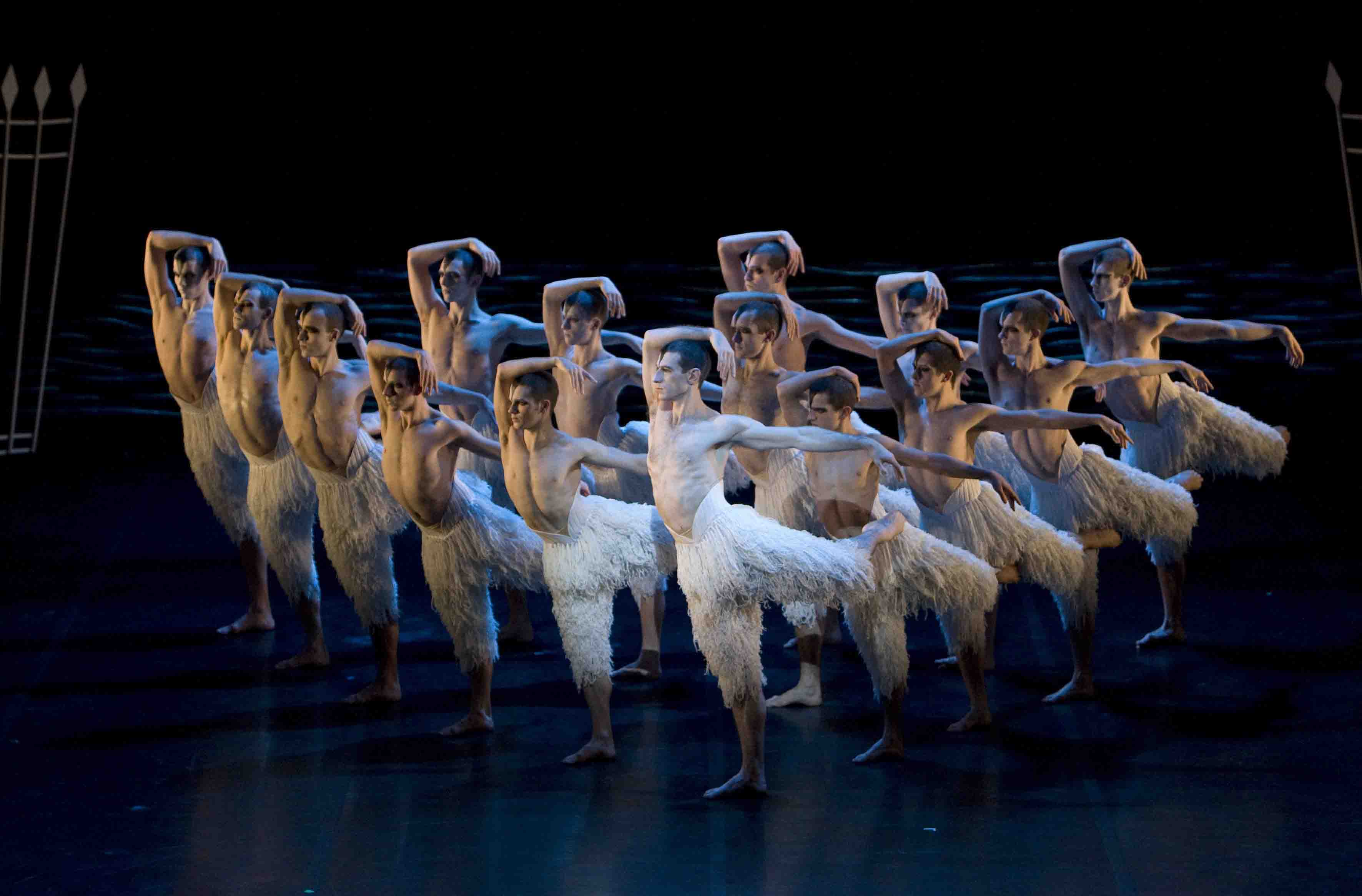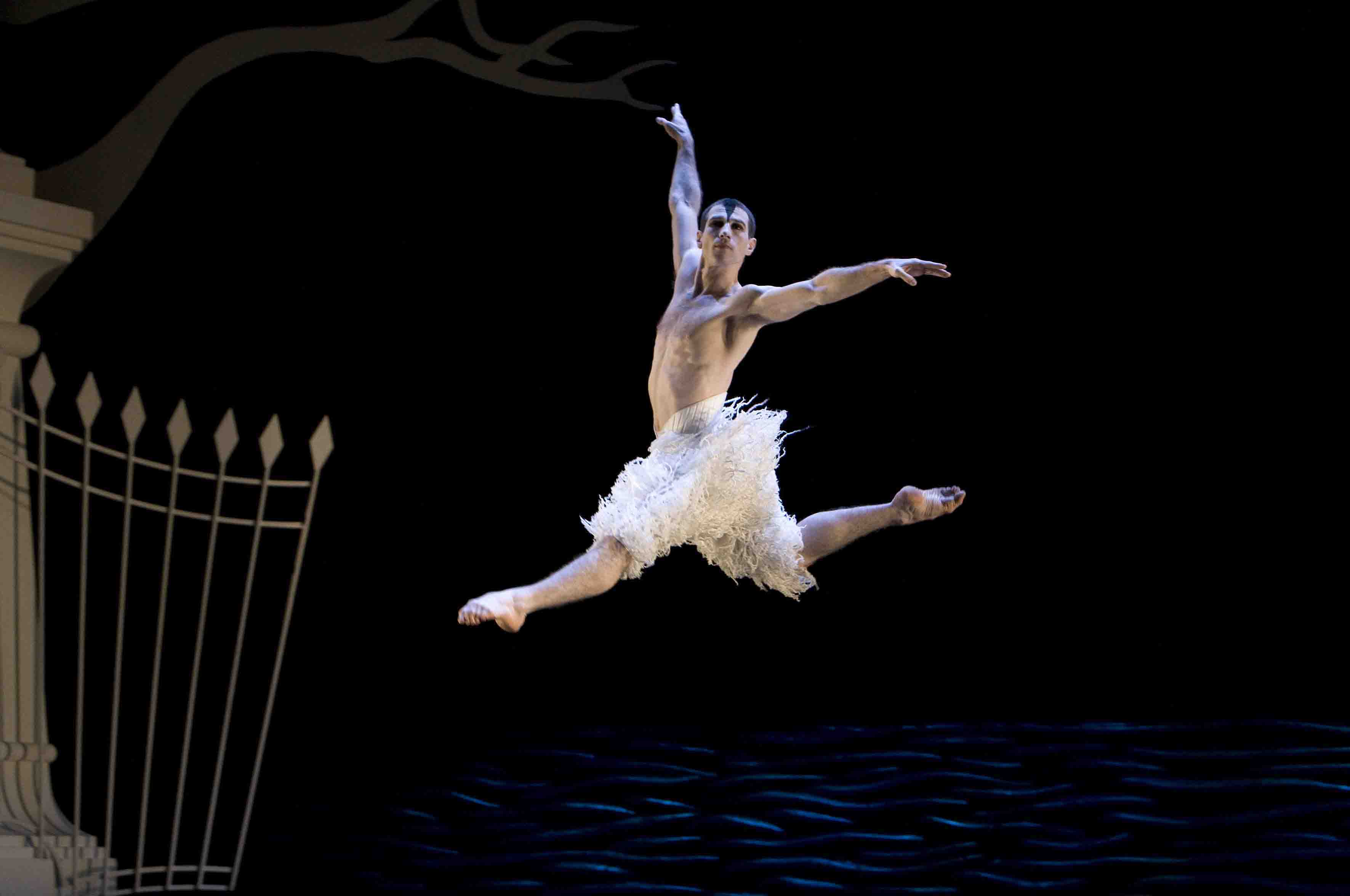Matthew Bourne’s Swan Lake / New York City Center / October 13 – November 7, 2010
Once upon a time, as Matthew Bourne tells us, there was a crown prince, a supersensitive fellow with an emotionally frozen mother (see Freud). Naturally, he gets himself entrapped by a tiara-coveting floozy (see the tabloids’ take on royalty), all the while fumbling at and fretting over the arid court duties he despises.
His instincts for romance, sex, true love, freedom from constraint, even rendezvous with danger–every young man’s birthright, wouldn’t you agree?–lead him down an unusual path. Moonlit, it takes him to the water’s edge, where he encounters the flock of swans he has often dreamed of. (At home in bed, his sleepy-toy is a plush swan.) The leader of the flock, called simply The Swan, and indeed all of the others are male–with shorn heads and bare chests chalked white, faces scored by an inky streak suggesting a beak, nether parts concealed to the knees with thickets of white feathers. Moving with heavily muscled grace–now blunt, now sensuous–they convey a terrifying power.

Swann’s Way: Jonathan Ollivier (front & center) and his flock in Matthew Bourne’s Swan Lake
Photo: Bill Cooper
I can’t wait any longer to say that the current version of Matthew Bourne’s Swan Lake, at City Center through November 7, is the most gratifying re-invention of the Petipa-Ivanov Swan Lake, I’ve ever had the good luck to see. The production, a significant reworking of the piece since its first New York run in 1998 (it premiered in London in 1995), gives it far more meaningful dance–in terms of steps, gesture, and deeply visceral execution–and this is exactly what it needed.
Set to a recording of Tchaikovsky’s evocative score (essentially uncut) for the original ballet, Bourne’s Lake operates in three different arenas–often simultaneously. The simplest is an account of royal life, which turns palace into prison, encourages covert misbehavior (Her Majesty’s daily agenda is a mix of opening exhibitions, christening sea liners, and secret trysts), and suppresses basic human instincts so that they must be converted into over-the-top dreams. The second is an account of the life of the id, which can be thwarted but, blessedly, never fully quelled. Last but far from least is the spinning of a complex and subtle relationship of the Bourne version to the traditional Swan Lake. The latter is, of course, the emblem of classical dance, with its tragic tale of the poignant Odette, transformed into a swan by a wicked, perhaps lascivious, magician; her evil alter ego, Odile (a single ballerina usually portrays the stories of both O’s); and Prince Siegfried, who is fatally distracted by the glittering bad girl into mistaking her for the good one.
This multilayered arrangement is ambitious and, to be frank, it doesn’t always cohere. Nevertheless, as with Alexei Ratmansky’s wonderful Namouna, you forgive the little lurches because the material is so fertile and engaging and its treatment so f
The top stars of Bourne’s Lake on the night I saw it (the taxing main roles are double-cast) were Simon Williams as The Prince and Jonathan Ollivier in the dual role of The Swan (Odette) and The Stranger (Odile). Williams, persuasive because of his boyish looks and earnest attitude–like those of the young Baryshnikov–is a very good dancer and a resourceful actor (when he despairs, as he often does, it’s hard to resist giving him instant empathy.)

Ollivier as the Odette figure in Matthew Bourne’s Swan Lake
Photo: Bill Cooper
Ollivier is a remarkable dancer–long and lean, with a space-slicing leap that conjures up an image of a sword doing its worst. In his Odette guise, he’s a mournful outsider seeking a love he yearns for but has never known. In his Odile incarnation (wearing provocative black leather trousers) he is raw, ruthless, and commanding. Crashing a dressed-to-kill party at the castle, he makes aggressive sexual overtures to every femme in sight, doing double duty with The Queen (Nina Goldman, cool even at her most randy) and turns the presentation of the princesses auditioning for the role of Consort to the Heir Apparent into a satisfyingly wild orgy.
The high point of the dancing is the love pas de deux for The Prince and The Swan. The duet has a vein of antagonism–often a part of lovemaking–but inevitably the two succumb to the white heat of their mutual attraction. The movement vocabulary is, first and foremost, very creaturely, full of well-observed swan mannerisms and extensions of them. The Swan nuzzles The Prince with the sweetness of an adolescent newly aware of physical love. The Prince lifts The Swan so that the bird appears to take flight in all its wide-winged magnificence and the image becomes a metaphor for the notion that both partners are soaring high–on the joy of finding, against all odds, the perfect mate.
The ensemble extends the idea of the wild, free animal driven by primal instincts with movement that’s bold and weighty, sinewy and sensuous, insinuating a danger that’s implicitly evil.
The Prince achieves ecstatic release in his mating with The Swan at the price of his life (and The Swan’s life too). True to their breed, the swans in this covey are vicious when the objects of their attachment are threatened. (Once, in Central Park, I fled from a male swan that decided I was getting too close to his cygnets.) The swans turn on their leader and his lover and destroy them. But Bourne allows his Swan and Prince the apotheosis tradition calls for. Through a skylight in the Prince’s bedroom the pair can be glimpsed together–at last and forever. I didn’t weep when I saw this last night, but now, remembering it and writing about it, I feel, welling up, the tears it has earned.
Admittedly I’m a Janey-come-lately to admirers of this show. I managed to resist it–vigorously–at its New York premiere a dozen years back, though it subsequently copped three Tony Awards. The production has been touring worldwide ever since, applauded by a great range of spectators, from balletomanes to folks cheerfully unaware of–or perhaps immune to–the pleasures of classical dancing. Meanwhile Bourne has created other works for his company, New Adventures, several of them with similarly oblique takes on landmark works of art. I hope that next time round, I’m quicker to catch on.
© 2010 Tobi Tobias




How lovely and evocative. Tears forthcoming. (I’ll never make another “Swine Lake” Bourne joke again.)
My take was very different, and much more like your original reaction a decade ago. In short:
1. Incoherent plot, cheap vaudeville or “music hall” jokes.
2. Inability to decide whether it is a send-up or serious rethinking.
3. Endlessly repetitive gestures, steps, emotions (e.g., racing into and out of the wings, coy and imitative swan movements), etc.
4. Some good dancers, others questionable, so uneven.
5. Obvious Freudian undertones: the prince, rejected by his mom, goes for a floozy, then meets a swan who will ultimately cause his death; the Odette/Odile swan who for a while couldn’t make up his mind as to whether he wanted men or women or whatever. Then the swan chorus as Rothbart, the queen really a caricature, half out of vaudeville, half serious.
6.Music blasting too loud and deliberate attempt to “wow” the audience with over the top “jokes” or massive moves, and a duet that struggles to be honest but remains evasive.
7. To me, all in all, irritating. Alexei Ratmansky is way beyond and above Bourne in imagination, choreography, and sensibility.
Sorry, but this was a great disappointment, and the ending a mushy melodramatic muddle.
A very evocative column, Tobi.
Good morning! I loved Matthew Bourne’s “Swan Lake” from Day One, and have seen perhaps a half dozen casts, perhaps more. I had more or less decided to give this revival a pass (canned music, you know), but you’re making me reconsider.
As for MB’s other works, my conviction is that they don’t measure up–certainly “Nutcracker!” and “Edward Scissorhands” do not. (Devoted to “Swan Lake” as I always was, I was certainly ready to be pleased.) Never saw his “Cinderella” or “Sylphide” gloss (“Highland Fling”). His “Play Without Words” was not much, and his contributions to “Mary Poppins” were purely decorative. His “Carmen” take (“The Car Man”), however, had some really wonderful stuff that dovetailed (ahem!) with the best of his Swan Lake.
Way to go, Tobi — this is really wonderful.
I agree, this version of “Swan Lake” is fascinating in many ways and tragic to the core; the many gaieties along the way only make the end more powerful. The finale itself is THE most upsetting catastrophe of all the versions of “Swan Lake” I’ve ever seen. I say that based on the video of the original cast.
When the show came to San Francisco, a couple of years ago, the star was a good dancer but not really classical, and he was more a bear than a swan. I found it disappointing, though I’d wanted to be swept away.
It’s particularly impressive that you’ve changed your mind. I wish you’d taken the liberty of digging into yourself to figure out what changed in you that made it possible for you to “get it.” Is it the dancers? Robert Greskovic [writing in the Wall Street Journal –Ed.] says this Swan is even better than Adam Cooper. Is that POSSIBLE?)
Or is it the whole fable? Now that Diana is way in the past and Prince Charles has been allowed to have Camilla — which I think is partly the result of this show — much, much, much has changed, not just in Britain but for all of us.
Tobi, This is gorgeous, compelling, passionate writing that I haven’t seen from anyone in our field in quite a while, and so evocative that it makes me long to jump on an airplane in order to see this incarnation of what has always been to me an intriguing work. I have seen it only on film, not the same thing at all as seeing it “live and in person” as my daughter used to say.
Obviously, the Bourne Swan Lake isn’t everyone’s cup of oo-long, as Bourne’s compatriot Noel Coward used to say, either in its original version, or what is perhaps now the revised standard, so I hope the debate will continue because all viable works of art deserve discussion.
I was not going to see it — too busy packing for my move.
After reading your review, I will go and see it.
This is a magnificent review, Tobi. You capture both the dancing and the dramatic subtleties of the ballet with such sensitivity and beautifully worded insight. Your description of the swans as “moving with heavily muscled grace–now blunt, now sensuous” is marvelous. I also love your observation that “you forgive the little lurches because the material is so fertile and engaging and its treatment so full of wit and blows to the heart.” And then there’s your evocation of the love pas de deux–powerfully expressed and very moving, as its subject deserves.
Interesting. I, too, have resisted this production. My husband and I talked yesterday with someone else who saw and enjoyed it. Maybe I’ll overcome my instinctive distaste for what seems to me something of a travesty.
While not fans of remakes in general, my husband and I did enjoy this performance immensely.